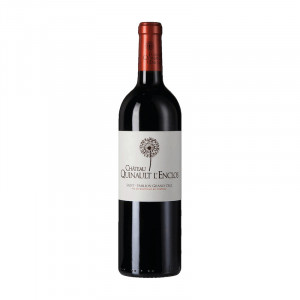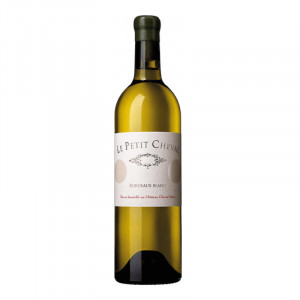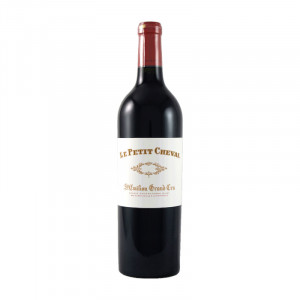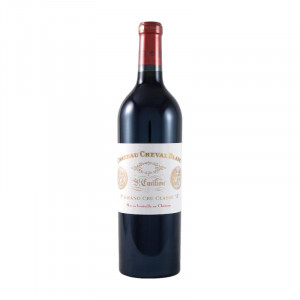Meeting with Pierre-Olivier Clouet
Today, we have the pleasure of stepping through the doors of Château Cheval Blanc in Saint-Émilion with its General Manager, Pierre-Olivier Clouet.
Upon arrival, the simplicity of the place contrasts with the grandeur of the Cheval Blanc name that lingers in the minds. Everything is elegant, orderly, and welcoming. There is an air of “homey” atmosphere with boots lined up at the entrance, books of all kinds flourishing in every corner, and the studious atmosphere that revolves around the fireplace at the reception. Pierre-Olivier welcomes us. A coffee, a mint candy, to get started, and he immerses us into the life of Cheval Blanc with the same ease as he crafts wines, that is to say, spontaneity and precision.
He unveils a management style imbued with closeness and authenticity, rooted in a rich field experience. A mindset that the owners cultivate to give wings to the estate, without denying its history and allowing the teams to step aside to reinvent the cru, a subtle dance of steps. As a member of the LVMH group, Cheval Blanc positions itself as a major player in changing the wine industry, and this responsibility goes beyond commitment to agroecology and agroforestry. He opens up about his almost intimate relationship with Cabernet Franc and also, about the unique project of Petit Cheval Blanc with a recurring question: “If Cheval Blanc were a white wine, what would it be?” A defining moment in his career.
The meeting with Pierre-Olivier underscores the connection between man, land, and wine; and reveals the depth of this exceptional property.
As General Director of Château Cheval Blanc since 2023, what's your management style?
I started as an intern in 2004. I was involved in pruning, pulling hoses… Today, I lead the boutique, but people still call me Pierrot and use informal language with me. All barriers have naturally been lifted, especially without any deliberate action. This kind of legitimacy changes a lot in terms of management with the teams. It’s a real asset because we have many challenges ahead of us!
How would you define the spirit of Cheval Blanc?
We have owners who manage Cheval Blanc like a family home. They make long-term decisions with a heritage vision. However, the leaders and the people who make the wine come from outside. So, it’s essential in this context to find the ability to transmit and let seeds grow within the team to take over. At Cheval Blanc, continuity has a very strong meaning.

What are the ambitions of the estate?
Our goal is to grow the Maison Cheval Blanc without necessarily increasing the number of properties we own. We have integrated Quinault l’Enclos in Saint-Émilion, Cheval des Andes in Argentina, and developed Petit Cheval Blanc. The challenge for a house like Cheval Blanc is to continue welcoming new additions to the family while remaining agile with a winemaker’s soul and without having to structure ourselves like a business. A fundamental question: what is the critical size? This tipping point where we lose responsiveness in decision-making. We know that making wine is a visceral feeling of the land where there are no recipes or protocols.
What are the pillars of the House?
Our alpha and omega rely on making a great, sincere wine that reflects the terroir and the vintage. We can then build many things around it because these fundamentals are solid.
What makes Château Cheval Blanc so unique?
Cheval Blanc comprises 53 plots, 10 soil types, predominantly Cabernet franc, a vision of maturity combining freshness and delicacy, tannins never overbearing, no cooking recipes, no extraction, no oenological products, no technology in the cellars; instead, meticulous work in the vineyard. We are both the Palais de Versailles and a contemporary art gallery where continuous creation occurs. Our ambition is not to say that Cheval Blanc must be the same as in the 18th century, even though we hold an incredible history of over 200 years. The challenge is to show that we have wings and that we are capable of reinventing the estate.

How does this translate into daily operations?
Today, plowing is no longer practiced. Yesterday, the goal was to harvest as late as possible. Now, we are facing a disrupted and warm climate. Everything is changing! Therefore, we must integrate these new factors to preserve Cheval Blanc’s fundamentals while evolving with the times and societal expectations, making wine in the most beautiful way possible with the new generation, or bringing satisfaction to our clients in Hong Kong, Singapore, or Mexico who don’t have the opportunity to have a vaulted cellar.
What does agroecology entail?
Beyond agroforestry, we are particularly interested in the broader definition of agroecology. The problem with these terms is that they are trendy and thus irritating… we end up censoring ourselves!
At the estate, the subject of agroforestry is based on three pillars that we have defined in our manifesto:
Natural soil fertility through no-plowing. We believe that plowing has been a vector of destruction in the agricultural world much more than mineral fertilizers and pesticides.
The tree has always been the farmer’s friend. It has rendered multiple services for heating, hosting biodiversity, producing organic matter, collecting water resources, and providing food… Biodiversity is created by farmers by providing shelter and sustenance to all living things. We do our part even though 39 hectares are insignificant for trapping the carbon of the planet! We spend billions to capture carbon when the best vacuum cleaner, we all know it. It’s the tree! It would be enough to increase organic matter in soils by 4 per 1000 each year to bring our planetary carbon balance to zero.
Polyculture. In 1890, Cheval Blanc’s maps indicated mixed cultures of fruit trees and vines. We have replanted differently and we produce fruits, vegetables, meat… on the estate because we want to do our part in diversifying crops. However, let’s be honest, we will not make a living by selling fruits. Monoculture is the beginning of all troubles. If you put a thousand cows fed with soybeans in a barn, it’s obvious that there will be problems. When you stand at the foot of the villages of Vosne Romanée or Saint-Emilion and look at these magnificent vineyards classified as UNESCO World Heritage, no one is offended by not seeing a grain of cereal, a hedge, or an animal. We have organized a magnificent monoculture…

What responsibilities come with being part of the LVMH group?
We are fortunate to be owned by visionary, established, and financially strong families. Therefore, we have the responsibility, the leisure, and the opportunity to shape the society of tomorrow. We have a huge lever in our hands to try to impact the change in farming methods or the agricultural shift much more than the wine industry in France. There is a form of responsibility linked to the fact that we have the financial means as well as the human resources. We are attractive to our customers and also to young people coming out of schools. We are very committed to funding fundamental research because we believe in it.
What are the challenges of tomorrow?
The big question for us is: what can a Maison like Cheval Blanc bring to its territory, its sector, or its region? Our wines are sold 80% abroad. It’s wonderful, but how do we bring this wealth back to the territory? This is a challenge for which I don’t have an answer.
However, we have two great strengths. Legitimacy. People may dislike us, but they cannot accuse us of not being serious. It’s up to us to use it for a solid shift in agricultural and societal issues. Secondly, we have a voice. When we take a stand, we are listened to. These are two fundamental things that we must use for the industry, which is in a very bad state today. However, it’s difficult to know what needs to be done.

What's your relationship with Cabernet franc?
Let’s start with a bit of ampelography. Cabernet franc is written without a capital letter because it’s an adjective. It is the parent of Bordeaux grape varieties. It was crossed with Sauvignon Blanc to create Cabernet Sauvignon and with Madeleine des Charentes to produce Merlot. Before phylloxera hit Bordeaux, there were mainly Malbec and Cabernet Franc, but the latter disappeared due to its difficulty in cultivation.
It’s somewhat of a diva. It sings beautifully, but it has a terrible character. When you harvest it too early, it’s green; too late, it’s overripe! It hates rain but also drought. It’s a fantastic grape, but it lacks agronomic plasticity and therefore doesn’t tolerate mediocre terroirs. However, it’s fortunate to have been little cloned by nurserymen.
In the 1980s, Pierre Lurton fought to preserve this Cabernet Franc grape variety in the face of the trend for oaked wines. This visionary decision is a boon for us today. As Coco Chanel said, “Fashion fades, only style remains.”
Cabernet franc is somewhat of a diva. It sings beautifully, but it has a terrible character.
What's the future for this grape variety that's making a comeback?
Cabernet franc will be a huge challenge for the wine world. It’s trendy, and everyone wants it because it’s seen as a miraculous solution to climate change since it’s fresh and elegant. But everyone forgets that it hates drought! It will be suitable for clay-limestone soils but not at all for gravel or sandy soils. We’re taking a shortcut that will be very painful because planting decisions today will have consequences in 20 years. The wine world is very sensitive to trends, just like pastry or dance might be. But in wine, it differentiates between terroir wines and designer wines.
In 2014, you launched the first vintage of Petit Cheval Blanc. What was the intention behind this project in which you were involved overall?
It all started with a desire from our owners, especially Albert Frère, when we bought La Tour du Pin. He wanted a white wine, a pleasure cuvée to share with family. So, in 2009, we grafted half a hectare of white onto reds. It wasn’t intended to be a great wine. After two years, the project took a different direction. Now, the owners wanted us to work on a great white wine at Cheval Blanc.
Pierre Lurton then proposed to the team to think about this project with one question in mind: if Cheval Blanc had been a white, what would it have been? The fundamentals were complexity, aging potential, and density.
What style are you aiming for with this Sauvignon Blanc?
The guiding principle is a white wine made by winemakers who have a red wine mindset. This means that in the vineyard, we have low vigor, small grapes, leaf removal on the east side… We aim to tone down the aromatic intensity of Sauvignon Blanc to seek more complexity. Denis Dubourdieu had a beautiful expression to illustrate that intensity is the enemy of the taster: “Just because you speak loudly doesn’t mean you’re saying interesting things.”
We have long aging periods of 20 to 22 months on full lees in large oak barrels and wooden tanks of 15 to 30 hectoliters, and a bit in demi-muids. The result, whether one likes it or not, is a wine that has its own style, a certain repeatability, and a strong commitment to being the white counterpart of our red.
What has this white project brought you?
Being offered such a project from scratch in a house with 200 years of history and wines at the level of Cheval Blanc is exceptional. We were allowed to take a step aside without denying Cheval Blanc’s history. We had significant risks to take during this creation, and Pierre was very demanding with the teams to ensure the integrity of the Cheval Blanc brand remained intact. It’s also worth noting that such a project is also a way to keep a team involved, willing, and loyal. It’s unifying.
Has working on a white wine changed your overall approach as a winemaker?
Yes, it’s evident that we no longer make red wine in the same way! You can discuss this with Julie and Baptiste at Château Lafleur. White wine requires great precision in wood management, oxygen, or clarification. When we start harvesting the reds, we already have 250 hectoliters of white juice vinified, tasted, and worked on in the cellar.

You also have other properties in Bordeaux and Argentina, what are the interactions?
Quinault l’Enclos and Cheval des Andes are different and wonderful projects, especially for one reason. We always envisioned them at the beginning as estates or houses that were fortunate to have the Cheval Blanc team looking after them. With the passage of years, these estates are a blessing for Cheval Blanc!
In Argentina, we’ve been making wines for 10 years with 200 millimeters of rainfall and temperatures over 35 degrees Celsius for one month of the year. With the team, we know these challenging contexts, and then, we produce two vintages per year. Enough to keep up the pace! Quinault l’Enclos, on the other hand, is a way to stay humble. It’s somewhat our equivalent of the “village” appellation in Burgundy!
What have been the highlights of your career?
The construction of the new cellar in 2011 marked the beginning of the story of this new team inventing the Cheval Blanc of tomorrow. At 28, I found myself leading the people who had been my mentors during my internship. Pierre didn’t impose changing what was in place, but rather inventing what we would do tomorrow. What would the cellar of Cheval Blanc look like in the future? It was an incredible opportunity to write a new blank page.
The frost in 2017 was another defining moment, even though my income and life didn’t depend on it, unlike other colleagues. It was a trial because we lost half of the harvest. For the first time, I became aware of our fragility and hyper-dependence on climatology. The climate issue is the problem of tomorrow. We will have to accept new paths without testing them because we don’t have time.

What inspires you on a daily basis?
Today, agriculture in the broadest sense inspires me a lot. With the team, we taste and meet many other winemakers. We have built ourselves a lot through viticultural exchanges. Today, we learn more by talking with pig farmers, cereal growers who produce old seeds, traditional bakers, brewers, beekeepers, gardeners…
Portrait
Book: “L’homme qui plantait des arbres” by Jean Giono
Film: “La gloire de mon père”
Music: Classical, it poses a challenge for me
Scent: Bergamot
Meal: Blanquette de veau
Vintage: 2011 for Cheval Blanc. It’s a misunderstood wine, and it annoyed me a lot because it’s a very grand Cabernet Franc. This vintage brings me back to the humility that all producers must have, that the notoriety of their wine is not due to their opinion. This point is very personal, but we have no impact on the market’s perception of the vintage.
Memorable bottle: A few years ago, we blind-tasted a Château Rayas white with the team. Arnaud de Laforcade, the commercial director, immediately identified the wine even though he was the only one who wasn’t a technician around the table and had never tasted it before. It was a memorable tasting moment!
Wines related to the article :
Photos et propos recueillis par Marie-Pierre Dardouillet, Cépages communication pour Vignobles et Châteaux













